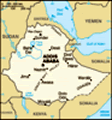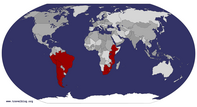Advertisement
Published: March 11th 2012
We fortified ourselves for the first day of our TESFA trek by having a huge lunch of Ethiopian food at a local restaurant. It was my idea of a perfect meal: a huge piece of injera with many little types of food arranged around it, such as pickled vegetables, spicy goat meat, shredded beets and lentil sauce. I thought of it as Ethiopian tapas and once I’d discovered it, I ordered it every chance I could get!
The TESFA arrangement with the local villages in the Ethiopian highlands around Lalibella was unique as far as our travel experience went. The local villages would build a group of tukuls, or huts, at a scenic place within a certain distance of their village. Trekkers would spend the night at these huts, being hosted by a different village each night. Every day, the local guides from the next village would meet ourselves and our TESFA guide around lunchtime, transfer our luggage to their donkey, and the previous villagers and donkey would take their leave. Each host village had a manager who was a liaison with TESFA and who would manage the funds and organize the food and the village girls who would cook
for us. The tukuls were extremely comfortable with mattresses, thick wool blankets and strong walls and thatched roofs to keep out the drafts. The only exception was a brand new site (we were only the second set of guests) where the glass windows had not yet been installed in the tukuls. There were no shutters either and this happened to be the site at the highest altitude, so it was extremely cold at night. I managed to get a good night’s sleep with three wool blankets and my sleeping bag but I have no idea how the guides and cooks didn’t get hypothermia or frostbite! During dinner we all huddled around the cooking fire, sitting on plastic oil jugs, trying to keep our sleeves and pants out of the flames as we passed the food around. It was definitely a memorable evening.
As you will see from the pictures, the tukuls were also perched on the tops of the escarpments so the views were amazing. Each site also had its own “loo with a view” with a window overlooking the valley. The food was also exceptional with local honey and eggs for breakfast (and thick slices of wheat bread
which I couldn’t eat but which Chuck relished), usually rice, pasta or potatoes with spinach, cabbage and a spicy lentil and onion sauce for dinner, and leftovers with injera for lunch. Chuck would say the best part was the coffee. It was usually made from freshly roasted and ground beans and served in small cups with a bit of sugar or honey. We were also usually offered a thyme and ginger tea as soon as we arrived at the tukuls after a long day of hiking.
An honourable mention goes to the village with whom we stayed on our third night. They had a tradition of offering footbaths and calf massages when you arrived at the tukuls. It was heavenly! Also, the village who built the tukuls where we stayed on the fourth night had thought to include a bucket shower. A bucketful of lukewarm water and a chunk of soap never felt so good!
When asked by TESFA during our e-mail communications if we wanted an “easy”, “moderate” or “strenuous” trek, we chose “strenuous”, assuming that we would get the best views that way. We also figured that we would be in shape and acclimatized from ourMount

 Taking a break for a lollipop
Taking a break for a lollipop
Notice our guide on his cellphoneKenyatrek the previous week. What we didn’t realize was that “strenuous” meant 25km per day! On our second day, we took a slight detour to climb Abuna Yosef mountain, which meant a total of 31km! Abuna Yosef is the third-highest mountain inEthiopiawith an elevation of 4300 m, so much of this hiking was done at altitude. If I hadn’t hadMount Kenyaas a training week, I would have been suffering! As it was, our guide, the local guides from the villages and the donkey carrying our large duffel bag would stride along chatting away (well the donkeys weren’t very chatty but they could sure keep up the pace!) as I huffed and puffed my way up the steep escarpments. Chuck was fine as well and usually would walk behind me so that I wouldn’t fall too far behind (and to act as a cattle prod every once in awhile). Our guide was great though, and despite not having the “pole pole” attitude, he encouraged frequent breaks (or at least asked me if I needed one to which I always responded “yes!) and didn’t tell us that we were attempting 31 km until we had succeeded, knowing that I might have balked

 Climbing up some steps
Climbing up some steps
You can see the first set of tukuls on the top of the escarpment in the middle of the photoat the idea. A highlight was a couple of km that I got to ride on a mule! A man came along on his way to market and asked our guide if I would like a ride. He wouldn’t accept any money as a tip and he even carried my daypack! The mule was amazingly sure-footed and picked his way along with no direction needed from me. I just had to hang on to the wood-and-leather saddle and try not to fall over the steep ledges that we were navigating!
Our guide was also very knowledgeable about local plants and village customs. In several villages that we passed along the way he had asked the local guide if they would arrange for us to see a certain activity. We saw threshing, rope-making (which our guide himself demonstrated) and we stopped at a school where the kids all ran out to greet us. Despite the fact that we were hiking over rugged terrain in quite remote locations, we were never really out of sight of people or human settlements. The sides of the escarpments were terraced for agriculture and there were sheep, goats, cattle and donkeys grazing on every available
plateau and even up on the ledges that we would have never been able to reach.
Most of the villagers were very interested in our progress and the kids would run along shouting “Hello hello hello” at the top of their lungs. Despite the snotty noses (which a group of British doctors, that we encountered on our last night, told us were due to smoky fires and dusty tracks), shabby clothes and sparse nutrition, the kids seemed happy, energetic and social. One young girl came up to the tukuls as I was sitting outside writing in my journal and she wanted to practice her English. We went through all of the body parts that I could think of and had started on “window” and “door” before the local guide came along and scolded her for bothering me. Unfortunately I didn’t know how to explain in Amharic that it wasn’t a bother at all!
A definite highlight of the trek was our sighting of the Ethiopian wolf. It is the most endangered species of canine that has not been extinct in the wild, with only about 550 remaining. We had been told that we would be hiking through its

 Another adventurous spot
Another adventurous spot
The donkeys took the long way roundhabitat but I had assumed that it was nocturnal and even if it wasn’t, that it would run away as soon as it heard or smelled us, let alone at the sight of us. It turned out that they do hunt during the day, and about mid-morning on our third day of trekking, our guide spotted two of them! Luckily I had kept my binoculars in my day pack (I had contemplated putting them in the donkey-pack that morning!) and we were able to watch the wolf walk through the grass and climb a rock to have a look around. We were at quite a distance but Chuck got a couple of good photos and it was a great sighting. With our African wild dog sighting inBotswanaand the number of sightings of Black rhinos that we’ve had, in Kruger and in Ngorongoro Crater, we have had exceptional luck on this trip.
In all, the week spent trekking in the Ethiopian highlands with TESFA was one of the best of our trip. It definitely whetted our appetites for a return trip toEthiopia. I would highly recommend a trek to anyone planning to travel to the Lalibella area. The Ethiopian landscape,
people and food were unique to the rest of our travels inAfricaand we were extremely happy with our decision to spend the last week of our trip exploring what little we could.
I returned to Lalibella tired and sore and several pounds lighter, but proud of myself for accomplishing two relatively difficult hikes in two weeks. I was also ready for a hot shower, another delicious meal at Ben Abeba restaurant in Lalibella, and a couple of days spent sight-seeing inAddis Abababefore flying home toCanada!
Advertisement
Tot: 0.101s; Tpl: 0.017s; cc: 16; qc: 65; dbt: 0.0588s; 1; m:domysql w:travelblog (10.17.0.13); sld: 1;
; mem: 1.2mb






















